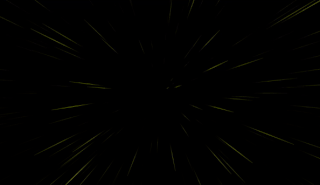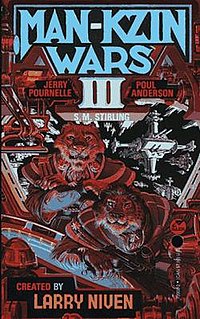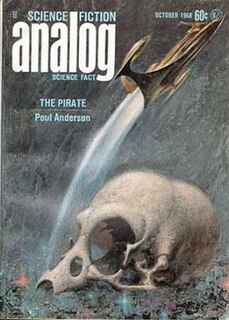Known Space is the fictional setting of about a dozen science fiction novels and several collections of short stories written by Larry Niven. It has also become a shared universe in the spin-off Man-Kzin Wars anthologies. The Internet Speculative Fiction Database (ISFDB) catalogs all works set in the fictional universe that includes Known Space under the series name Tales of Known Space, which was the title of a 1975 collection of Niven's short stories. The first-published work in the series, which was Niven's first published piece was "The Coldest Place", in the December 1964 issue of If magazine, edited by Frederik Pohl. This was the first-published work in the 1975 collection.
A future history is a postulated history of the future and is used by authors of science fiction and other speculative fiction to construct a common background for fiction. Sometimes the author publishes a timeline of events in the history, while other times the reader can reconstruct the order of the stories from information provided therein.

The Time Ships is a 1995 hard science fiction novel by Stephen Baxter. A canonical sequel to the 1895 novella The Time Machine by H. G. Wells, it was officially authorized by the Wells estate to mark the centenary of the original's publication. The Time Ships won critical acclaim. It won the John W. Campbell Memorial Award and the Philip K. Dick Award in 1996, as well as the British Science Fiction Association Award in 1995. It was also nominated for the Hugo, Clarke and Locus Awards in 1996.

A megastructure is a very large artificial object, although the limits of precisely how large vary considerably. Some apply the term to any especially large or tall building. Some sources define a megastructure as an enormous self-supporting artificial construct. The products of megascale engineering or astroengineering are megastructures. The lower bound of megastructural engineering might be considered any structure that has any single dimension 1 megameter (1000 km) in length.
"Arena" is the eighteenth episode of the first season of the American science fiction television series Star Trek. Written by Gene L. Coon and directed by Joseph Pevney, the episode was first broadcast on January 19, 1967.

In science fiction, hyperspace is a concept relating to higher dimensions as well as parallel universes and a faster-than-light (FTL) method of interstellar travel. Its use in science fiction originated in the magazine Amazing Stories Quarterly in 1931 and within several decades it became one of the most popular tropes of science fiction, popularized by its use in the works of authors such as Isaac Asimov and E. C. Tubb, and media franchises such as Star Wars.

Hyperdrive is a British television science fiction sitcom broadcast by BBC Two in 2006 and 2007. Set in 2151 and 2152, it follows the crew of HMS Camden Lock as they stumble through their heroic mission to protect British interests in a changing galaxy.
Dark matter is defined as hypothetical matter that is undetectable by its emitted radiation, but whose presence can be inferred from gravitational effects on visible matter. It has been used in a variety of fictional media, including computer and video games and books. In such cases, dark matter is usually attributed extraordinary physical or magical properties. Such descriptions are often inconsistent with the known properties of dark matter proposed in physics and cosmology. For example, in computer games, it is often used as material for making weapons and items, and is usually depicted as black or a similar color.

"Ring Around the Moon" is the fourth episode of the first season of Space: 1999. The screenplay was written by Edward di Lorenzo; the director was Ray Austin. The shooting script is dated 14 December 1973 with green page amendments dated 17 January 1974; the final shooting script is dated 8 February 1974. Live-action filming took place Wednesday 27 February 1974 through Thursday 14 March 1974.

The Man-Kzin Wars is a series of military science fiction anthologies and is the name of the first. The short stories detail the eponymous conflicts between mankind and the Kzinti, set in Larry Niven's Known Space universe. However, Niven himself has written only a small number of the stories; most were written by other science fiction writers, as Niven opened this part of the Known Space to collaboration in the form of a shared universe. The cover art for the books in the series is created by Stephen Hickman.

In speculative fiction, floating cities and islands are a common trope, which range from cities and islands that float on water to ones that float in the atmosphere of a planet by purported scientific technologies or by magical means. While very large floating structures have been constructed or proposed in real life, aerial cities and islands remain in the realm of fiction.

Inconstant Star is a science fiction fix-up novel by American writer Poul Anderson. It is formed by the novellas Iron and Inconstant Star, first published in The Man-Kzin Wars (1988) and Man-Kzin Wars III (1990), respectively. The title is from the tumbling alien artifact that sends out radiation. Due to the tumbling effect, the output can only be seen briefly from a given point in space, looking like a star, but then disappearing as the artifact moves.

Question and Answer is a science fiction novel by American writer Poul Anderson. It originally appeared in the June and July 1954 issues of magazine Astounding Science Fiction, and was later reprinted in 1956 as part of Ace Double D-199 under the title Planet of No Return, and again as a stand-alone Ace novel in February 1978 under the original title.

The Psychotechnic League is a future history created by American science fiction writer Poul Anderson. The name "Psychotechnic League" was invented by Sandra Miesel during the early 1980s, to capitalize on Anderson's better-known Polesotechnic League future history. Anderson published 21 novels, novellas and short stories set in this future between 1949 and 1957, with a 22nd published in 1968.

"The Pirate" is a science fiction short story by American writer Poul Anderson that first appeared in the October 1968 issue of Analog. "The Pirate" was a prequel to the earlier Psychotechnic League novel Star Ways, and was the last story in the Psychotechnic series to be published. The story was included in the 1975 collection Homeward and Beyond and the 1982 collection Starship, and the timeline from the latter collection places the story in the year 3115.
Engineering on an astronomical scale, or astronomical engineering, i.e., engineering involving operations with whole astronomical objects, is a known theme in science fiction, as well as a matter of recent scientific research and exploratory engineering.

"Brake" is a science fiction short story by American writer Poul Anderson, first published in 1957 in Astounding Science Fiction and reprinted in the collections Beyond the Beyond (1969) and The Psychotechnic League (1981). As a component of the Psychotechnic League future history / alternate history, "Brake" takes place in 2270, as the civilization built up in the aftermath of the 1958 Third World War is being torn between mutually antagonistic factions, on the verge of collapsing into "the day of genocide and the night of ignorance and tyranny".
The space-opera blockbuster, Star Wars franchise has borrowed many real-life scientific and technological concepts in its settings. In turn, Star Wars has depicted, inspired, and influenced several futuristic technologies, some of which are in existence and others under development. In the introduction of the Return of the Jedi novelization, George Lucas wrote: "Star Wars is also very much concerned with the tension between humanity and technology, an issue which, for me, dates back even to my first films. In Jedi, the theme remains the same, as the simplest of natural forces brought down the seemingly invincible weapons of the evil Empire."

Space travel, or space flight is a classic science-fiction theme that has captivated the public and is almost archetypal for science fiction. Space travel, interplanetary or interstellar, is usually performed in space ships, and spacecraft propulsion in various works ranges from the scientifically plausible to the totally fictitious.